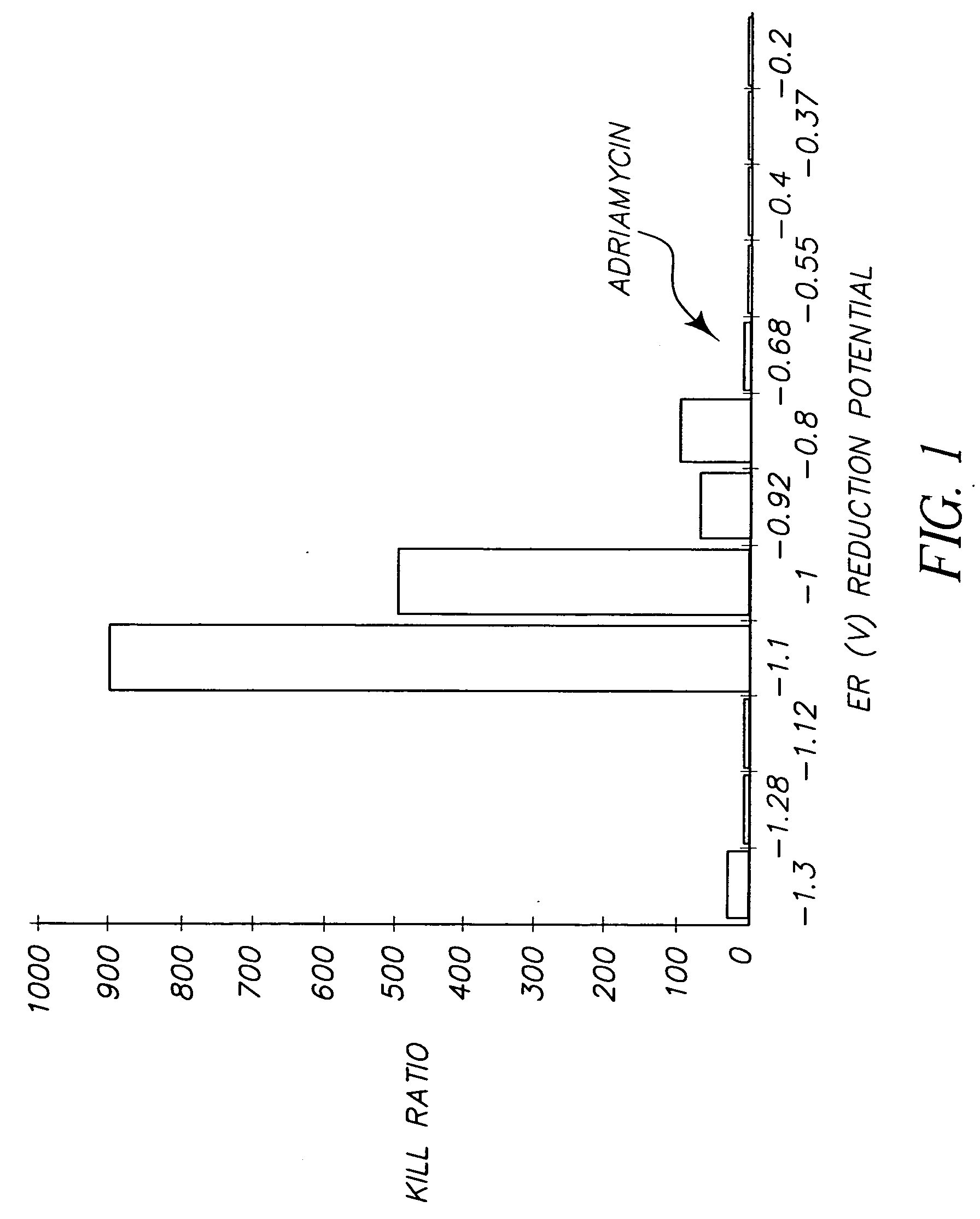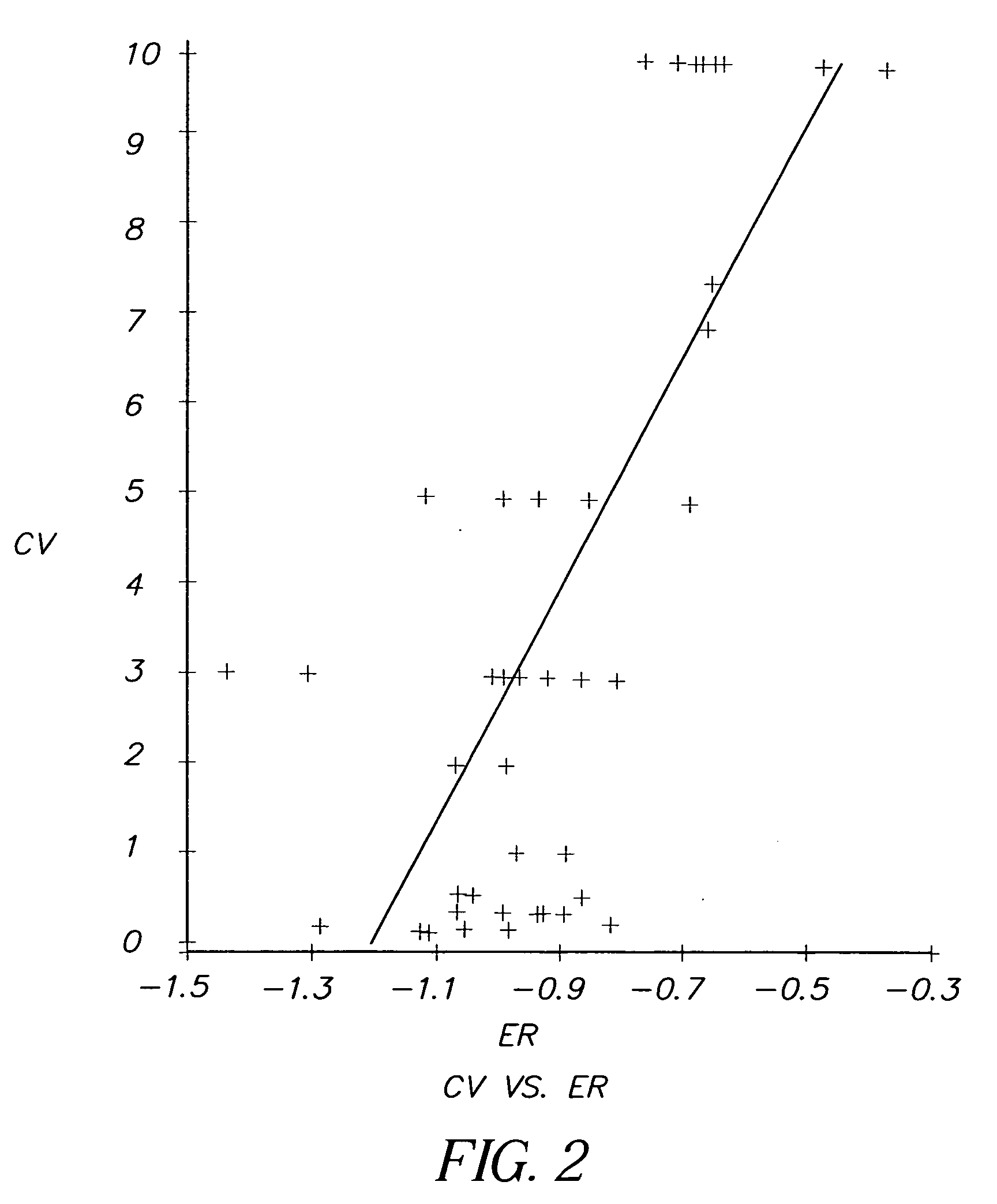Correlation of anti-cancer activity of dyes with redox potentials
a technology of anti-cancer activity and redox potential, which is applied in the field of cyanine and merocyanine dyes, can solve the problems of unpromising the conquest of malignant tumors, strong toxic to normal cells, and pain and incapacity, and achieves strong anti-cancer activity, high anti-cancer activity, and high anti-cancer activity.
- Summary
- Abstract
- Description
- Claims
- Application Information
AI Technical Summary
Benefits of technology
Problems solved by technology
Method used
Image
Examples
example 1
[0124] Evaluation of Dyes from Kodak advertisement (See Science April 30:1976; Scientific American May 1976). Table 1 shows the first results from the testing. It is seen that 3 of the dyes from the 18 dye series which appeared in the Kodak Advertisement, showed considerable anti-cancer activity relative to adriamycin, a widely used chemotherapeutic anti-cancer agent. This is also illustrated by FIG. 2.
TABLE 1Initial Screening ResultsDyeER(v)Cell LineIC50SelectivityD-101−1.0610.50—Kodak Ad20.005100Dye 630.0313.340.0051005>1006.01507.0313.38>100AC-2−.92010.30—Kodak Ad2>60Dye 73>604>605>606>607>608>60D-150−.80813.0—Kodak Ad20.03100Dye 930.0310040.0310050.0130060.0215070.10308.01300Adriamycin−0.6810.8—20.551.530.051640.061350.1860.071170.081080.0516D-132−1.01——428.57−0.97D-133−1.03——333.5−0.99D-148−1.15——250D-135−0.88——200−0.84D-104−0.96——200−0.92D-105−0.86——112.5−0.82D-100−0.9——100−0.86D-168−0.9——100.0D-112−1.1——900
Description of Cell Line [0125] 1. CV-1 Normal Monkey Kidney Epithe...
example 2
[0135] From the screening of over 2000 cyanine dyes for anti-cancer activity, a number of cyanine dyes were discovered to have exceptionally strong anti-cancer actively with selectivities better than any anti-cancer agents reported to date. The anti-cancer results for dyes with selectivities equal to or greater than 60 are shown in Table 2.
[0136] It is seen that there are a wide variety of cyanine dye structures that show anti-cancer activity with selective kill ratios of 60 or greater.
[0137] Not all of the dyes evaluated had measured electrochemical reduction potentials. Of the 2000 dyes evaluated for anti-cancer activity, it was found that a number of dyes with electrochemical reduction potentials between —1.1 V and −0.8V showed selective kill ratios of 20 or less, possibly for reasons of solubility and steric factors. However, all of the dyes with selective kill ratios of 60 or greater that did have measured electrochemical reduction potentials, fit into a window of —1.1V to −0...
example 3
[0138] In general, it appears that carbocyanine dyes (3 methine carbon chain) have higher selectivity than simple cyanine (1 methine carbon) or dicarbocyanine dyes (5 methine carbons) for direct analogs. This apparent correlation may also be complicated if light is not eliminated completely during the screening process since the chain length has a high degree of influence on a dye's light stability. (See Under certain conditions, cyanine dyes can generate singlet oxygen, G. W. Byers, S. Gross, P. M. Henrichs, Photochem. Photobiol., 23, 37 (1976).) Dicarbocyanines and longer chain dyes tend to decompose readily in aqueous solutions in the presence of light.
TABLE IIIEffects of Methine Chain LengthZXmCVCXCV / CXD-165HS10.50.005100.0HS20.300.074.35,6-BenzoS00.100.00520.0D-1095,6-BenzoS10.3>60.0D-1625,6-BenzoS23.00.50604,5-Benzo500.080.00516.04,5-Benzo512.00.0310.0H00>3.2>0.3210.0H013.00.1030.0
PUM
| Property | Measurement | Unit |
|---|---|---|
| reduction potential | aaaaa | aaaaa |
| reduction potential | aaaaa | aaaaa |
| electrochemical reduction potentials | aaaaa | aaaaa |
Abstract
Description
Claims
Application Information
 Login to View More
Login to View More - R&D
- Intellectual Property
- Life Sciences
- Materials
- Tech Scout
- Unparalleled Data Quality
- Higher Quality Content
- 60% Fewer Hallucinations
Browse by: Latest US Patents, China's latest patents, Technical Efficacy Thesaurus, Application Domain, Technology Topic, Popular Technical Reports.
© 2025 PatSnap. All rights reserved.Legal|Privacy policy|Modern Slavery Act Transparency Statement|Sitemap|About US| Contact US: help@patsnap.com



